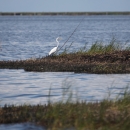States
MinnesotaOverview
The St. Louis River U.S. Steel Superfund Site, located in Duluth, Minnesota, is a former steelmaking and wire mill facility that began operations in the early 1900s. Historic operations released hazardous substances, including polycyclic aromatic hydrocarbons (PAHs) and heavy metals, into the environment. The Site was placed on the National Priories List in 1983 and includes 19 Operable Units in both wetland and upland areas. The Minnesota Pollution Control Agency leads remedial activities at the site. In 2016, U.S. Steel began working with U.S. EPA Great Lakes National Program Office to develop a complimentary plan to clean up contaminated sediment under the authority of the Great Lakes Legacy Act; the project was completed in 2024.
The Lower St. Louis River provides important habitat for fish and wildlife species. Priority resource needs that have been identified for this area include conserving and enhancing near-shore shallow water fishery habitat, nesting and rearing habitat for shorebirds, and wetland habitat. Within these habitats at the U. S. Steel Site, aquatic plants, benthic invertebrates, benthic and predatory fish, migratory birds, surface water, sediment, groundwater and aquatic and terrestrial resources have been exposed to the hazardous substances and have potentially been adversely affected. In addition, recreational services may have been reduced and Tribal resources may have been impacted.
Trustees
The Natural Resource Trustees are composed of the 1854 Treaty Authority (governed by the Bois Forte and Grand Portage Bands of Lake Superior Chippewa); Fond du Lac Band of Lake Superior Chippewa; State of Minnesota represented by the Minnesota Pollution Control Agency and the Minnesota Department of Natural Resources; U.S. Department of Commerce represented by the National Oceanic and Atmospheric Administration; and U.S. Department of the Interior represented by the U.S. Fish and Wildlife Service and the Bureau of Indian Affairs.
Assessment
Assessment Plan
The Trustees recently completed an Assessment Plan for the Site consistent with the Department of the Interior’s Natural Resource Damage Assessment (NRDA) Regulations (43 CFR 11.32). The Plan identifies how the Trustees may intend to assess injuries to natural resources such as fish, wildlife and wildlife habitat, and impacts to their use by the public. The NRDA process is distinct from closure and remedial activities.
Plan and Associated Documents
Administrative Record
To view publicly available documents, please see the St. Louis River U.S. Steel Administrative Record.




